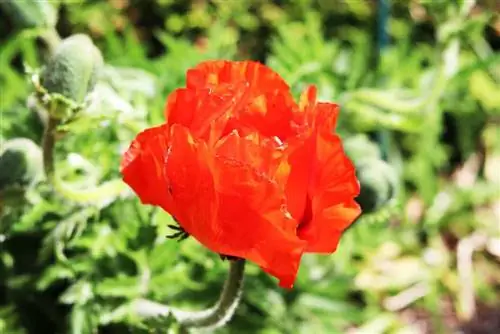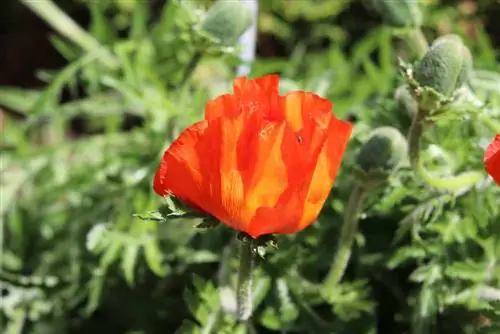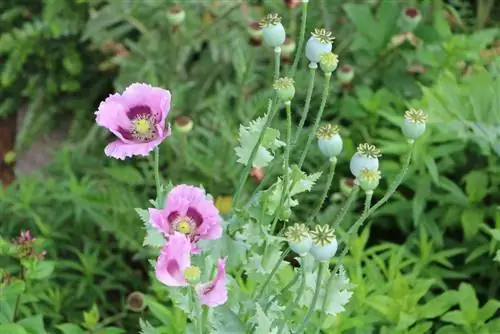- Author admin [email protected].
- Public 2023-12-17 03:39.
- Last modified 2025-01-24 12:45.
Turkish poppies provide one of the most beautiful splashes of color in the garden with their flowers. Bright orange and red run through the perennial. Even as the petals gradually say goodbye, they reveal a new gift: the unusually shaped seed capsule. Third in the group, the jagged, hairy leaves form a gray-green contrast. Maintain this oriental beauty with the right care.
Origin and names
Turkish poppies naturally come from Turkey. But not only. Its roots extend to Iran and the Caucasus. Turkish poppy is not its only name either. In everyday usage it is also called Turkish poppy, oriental poppy, oriental poppy, garden poppy, perennial poppy and fire poppy. The botanical name “Papaver orientale” is equally sonorous.
Key Features
The most important characteristics of this poppy plant are:
- perennial
- Deeproots
- tolerates drought and heat
- hardy down to -20 degrees
- milky sap in the stem is slightly poisonous
- Growth height: 50 to 120 cm
- large flowers up to 20 cm in diameter
Note:
Because of their deep roots, poppy plants are difficult to transplant.
flower colors
Typical perennial poppies are fiery red, just like the original variety that still grows wild in the mountains of Asia Minor today. However, garden lovers in this country can choose from a wide range. Numerous new varieties play with the element of color. Turkish poppies now bloom in white, pink, violet, purple and of course in countless shades of red. Small accents in the form of different colored spots also enrich the flowers. Popular varieties are:
- red flowering varieties “Alibaba” and “Tango”
- “Black & White” has white flowers with black dots
- “Pink Lassie” blooms in pink
- “Mambo” and “Marlene” are new varieties with a bluish shimmer
Tip:
Not everything has to bloom uniformly: for example, a white poppy stands out among many red varieties.
Flowering time
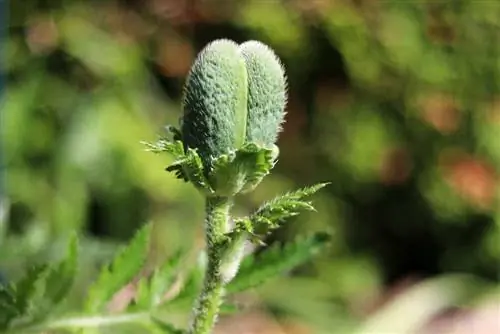
The flowering times also vary for the individual varieties. Many varieties are specially bred so that the poppy's short flowering times are spread over the entire summer. They begin in May and can extend into autumn.
- Early blooming are “Türkenlouis” and “Karine”
- This is followed by “Effendi” and “Aglaja”
- “Late bloomer” blooms late
There are many different varieties, so get detailed advice from specialist retailers. Here's how to find the variety that's right for you.
Tip:
Combine varieties with different flowering times to extend the overall flowering period.
Growth
Depending on the variety, the oriental poppy can grow between 50 and 120 cm tall. Short-growing varieties are more compact and stable. The small-growing varieties such as “Blickfang” and “Samba”, but also all other small-growing varieties, are well suited for the pot. Tall varieties occasionally require pruning to prevent the heavy flower stems from snapping.
Location
The fire poppy loves full sun places that offer it plenty of light and warmth. Partial shade is only suitable to a limited extent and complete shade is definitely recommended. The less light the Turkish poppy gets, the fewer flowers it produces. After flowering, Papaver orientale quickly loses its foliage and leaves an “empty” spot in the garden bed. For this reason, he should not be planted in the front row. The possible height of up to 1.20 m also makes it an ideal plant for the middle row of plants. Consider these two aspects when choosing a location.
Floor
The Turkish poppy comes from mountain meadows and chalky stone slopes to our pampered gardens. He maintains his modest demands. The ideal soil for the garden poppy can be described as follows:
- humous and sandy
- dry to slightly moist
- permeable
- deeply relaxed
- moderate nutrient content
- pH value neutral
- can be sandy or rocky
Tip:
You can mix heavy clay soil with a little sand to loosen it up. This makes root development easier and also prevents waterlogging.
Plant Neighbors

Many garden owners strive to cultivate as many types of flowers as possible. However, space is usually limited and the plants have to grow close to each other. The garden poppy will also have immediate neighbors. But not every neighbor is equally easy for him to tolerate. You can safely plant these types of flowers next to garden poppies:
- Bearded Iris
- Dahlias
- Cornflowers
- Daisies
- Marigolds
- larkspur
- Sage
- Tagetes
Tip:
Try to keep a distance of at least 40 centimeters between the individual plants so that each plant has enough space to develop freely.
Sowing
Turkish poppies are easy to grow from seeds. The best time to sow seeds is spring from April to June. Turkish poppy is a taproot plant and as such it does not tolerate transplanting well. It is better to sow the Turkish poppy directly at its future location in the garden or in a planter. The germination period is 2-3 weeks, provided the air temperature is at an optimal 15 to 20 degrees.
- Choose a suitable location in the garden or a large planter
- Prepare the soil. It has to be fine crumbly.
- Spread the seeds widely.
- Do not cover the seeds with soil, or only cover them very slightly, as they germinate in the light!
- Press the seeds lightly.
- Wet the soil carefully so that the seed is not washed away.
- Wait until the seeds germinate and develop into small plants.
- Single the Oriental poppy by leaving only a few, strong plants and pulling out the remaining seedlings.
Tip:
Water the sown seeds with a spray bottle. The fine water mist is light and the seeds stay in place.
If you don't cut poppy flowers, the seeds on the plant can ripen. The ripe seeds are dispersed by the wind and self-sow into the garden. Maybe you'll discover a new poppy plant here and there, without the hassle of sowing.
Root cuttings
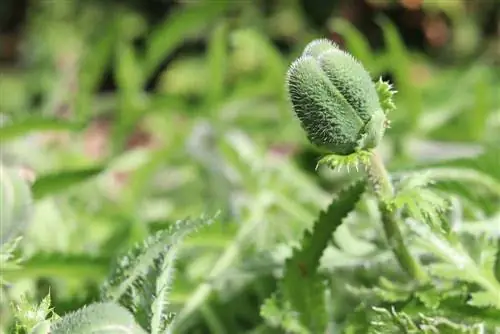
In winter you can cut root cuttings and grow new poppy plants.
- Dig up the roots.
- Separate some roots directly at the root collar.
- Cut the separated roots into pieces about 10 cm long.
- Bevel the bottom part of the sections.
- Plant the sections in a cool and moist place
After about 2-3 months, the planted root pieces will sprout.
Division
The poppy plant quickly develops in width. To prevent it from growing uncontrollably, it can be divided approximately every three years. Spring is the right season for this. The separated root parts can be used for propagation.
- Dig out the clump carefully without damaging the delicate taproot
- Divide the perennial with a spade or knife
- Select a suitable location.
- Plant the sections.
Pouring
The Oriental poppy is undemanding and needs little water. He is used to the extreme dryness and heat of his native homeland. However, if the heat continues for a long time and the soil dries out too much, the poppies growing outdoors need to be watered. Things look a little different with poppies that grow in pots:
- he needs water regularly
- the earth should never dry out completely
- Waterlogging must be avoided
- the pot should have drainage holes
- a drainage layer makes sense
Tip:
It is better to water your poppy seeds heavily with water after a few days rather than with smaller amounts every day. This promotes root formation and thus the stability of the poppy.
Fertilize
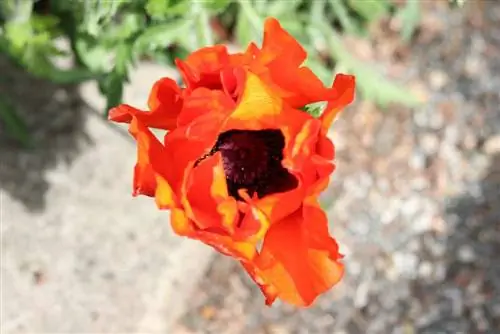
When fertilizing the poppy plant, it is important to be frugal. Turkish poppies are used to poor soils and require few nutrients. At the beginning of the new growing season in spring, some compost can be worked into the soil. That's enough to get a sea of flowers in summer. Another organic fertilizer can be used instead of compost. Further regular fertilizer applications are not necessary.
Note:
The Turkish poppy copes better with nutrient-poor soil, so avoid over-fertilization. This can easily happen if, for example, neighboring plants need to be fertilized more often.
Cutting
You are allowed to separate your Turkish poppy, but it is not necessary. After flowering in summer, it pulls in its above-ground parts anyway. After the foliage has withered, not much of the perennial can be seen until fall. After a rest period of 2-3 months, Turkish poppies sprout new leaves and then overwinter green. The following cutting measures are possible:
- Cut off stems after flowering if you do not want seeds to form
- Remove yellowed leaves for visual reasons
- The perennial can be cut down to 10 cm in autumn
- Cut the flowers for the flower vase, they last up to 3 weeks
Tip:
You can leave cut plant parts where they are, they are good winter protection for the perennial plant underneath. Morning is the best time of day to cut flowers for the flower vase. Select only slightly opened buds.
Pests
Like most other garden perennials, the Turkish poppy is not spared from pests. Aphids like to get their hands on the delicious plant sap. Check your perennials for lice at regular intervals and take appropriate measures immediately to keep the damage as minimal as possible.
On rainy days, when countless slugs crawl around everywhere, the Turkish poppy is defenseless against them. Its green, hairy leaves can quickly be razed to the ground. The voracious little animals must be stopped immediately and effectively. There are many tips circulating in this regard, but not all of them bring lasting success. Try out which control method is most practical for you and at the same time brings success.
If you react quickly to the snail plague, the snails will have little time to lay their eggs. You will be happy about fewer snails next gardening year.
Tip:
If you can spare some time, pick up the snails by hand every day and then release them somewhere in the “wild” where they can’t cause as much damage.
Diseases
Oriental poppies are weakened by prolonged moisture and are therefore susceptible to fungal diseases. Infected parts must be cut off and disposed of immediately. Use gardening gloves and then disinfect the cutting tool used to completely remove any traces of fungus. With bacterial blight, the leaves look blackish. Unfortunately, the perennial can no longer be saved. Finally, dispose of the entire plant in the residual waste. Under no circumstances should diseased plants be placed in the compost or simply left lying around.
Wintering
Turkish poppies are hardy, but should still be protected from severe frosts. In the fall, place a layer of brushwood over the newly sprouted leaves. In spring, as soon as severe frosts are no longer expected, the brushwood can be removed again.
In winter, the poppies in the garden don't need to be watered at all. Poppy seeds in plant containers should not dry out completely. Water it with a little water every now and then.

